 |  |  |
 |  |  |
 |  |  |
Momosuke Bridge and Modernization Heritage |
Yama no Rekishikan History Museum |
This building was constructed on the former Tsumago Post Town Honjin site as the Tsumago Local Office of Nagoya Branch Bureau of Imperial Estates on February 7, 1900. It held jurisdiction over the entire Nagiso region including Oga, Yomikaki, Azuma, Tadachi, and Yubunezawa. The building was in use until 1933 when it was deemed too old for official use, and the government office was transferred close to Azuma Bridge. The old building was sold to a private owner and used as a residence until 1986. The reconstruction of a National Road junction forced the building's deconstruction and removal. At that time, it was donated to Nagiso Town who placed it in storage. In 1990, the building was restored at its current location and was named the “Yama no Rekishikan” as a part of the Tenpaku Koen Development Project (a special project for regional development). |
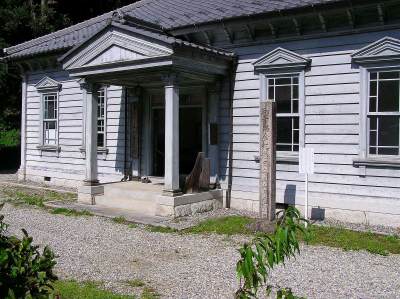 |
The building had gone through only a few reformations when it was transferred in 1933. It has been kept in a very good condition, both inside and outside. Most of the building's features, such as its sash windows, are the original pieces. It is not heavily decorated but stands as a beautiful and high-quality structure. The solid design is apparent throughout the building in aspects such as the composite construction of the pillar capitals of the door facing the driveway and the pediments over the windows. |
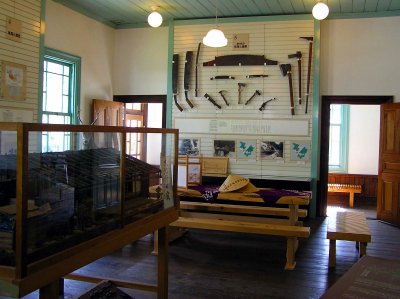 |
This exhibit summarizes the history of Kiso Mountains and displays kure (wood boards) and doi (wooden foundations for pillars) that were paid as a contribution to wood taxes in the Edo Period.
This exhibit explains the strict policy on the protection of forest resources in the Owari Domain, also known as “a head for a tree”. It displays documents related to Kiso’s unique wood tax system and the establishment of Tomeyama (managed forests) which banned any harvesting of timber and barred access by residents.
An exhibition of historical resources related to hinoki cypress hats from Araragi, a traditional craft since the Edo Period. Also displayed are documents related to licensed luggage policies that supported the status of hinoki cypress hats as a traditional craft as well as those related to woodworker’s lathes.
Information on falconry, a hobby of the Edo-Period shoguns and people's hardships that were caused by this hobby.
An exhibition of historical resources regarding timber and the production processes, from felling trees to transportation using forest railways and roads. There is an outdoor display of a locomotive that ran on the forest railway.
An exhibition of the foundations that were used for the front gates of the former Tsumago Local Office building of the Bureau of Imperial Estates constructed in 1900.
An exhibition of historical resources related to an incident in which the residents demanded a lift of the ban on the sale of state forests to the public. The leader of this incident was Hirosuke Shimazaki, elder brother of the novelist, Toson Shimazaki, and the head of Tsumago Honjin.
Momosuke Fukuzawa Memorial Museum |
Momosuke Fukuzawa, also known as the “King of Electricity”, was the first person to focus on the potential of the Kiso River as a power source. He built a villa in a beautiful area of Kiso in 1919 from which he commuted to the power plant construction sites in Yomikaki and Oi. |
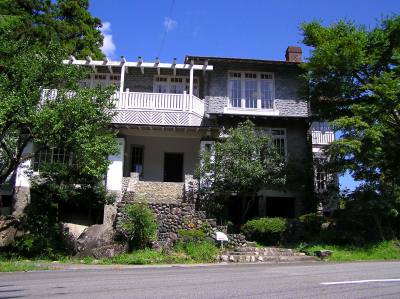 |
■ Open: Mid-Mar. to the end of Nov., 9:30 a.m. - 4:30 p.m.
■ Closed on Wed and during the winter season (Dec. 1 to mid-Mar.)
■ Admission (shared admission with the Yama no Rekishikan): Adult – ¥500, JHS students – ¥250, ES students and younger – Free.
■ TEL: 0264-57-4166
Momosuke Fukuzawa was born on June 25, 1968 in Yoshimi, Saitama. His family moved to Kawagoe City, Saitama when he was young. Momosuke entered Keio Gijuku (current Keio University) founded by Yukichi Fukuzawa, who acknowledged his talent and adopted him. Momosuke then went on to study in the U.S. He became a successful businessman in Nagoya from 1907 and launched numerous projects. Momosuke became involved in the electric power industry in 1908 and devoted himself in developing hydroelectric power generation on the Kiso River. He opened the Shizumo Power Station in 1919 reaching his zenith in 1923 when he completed Yomikaki Power Station. Also, known as the “King of Electricity”, he made significant contributions to Japan's industrial modernization. He died on February 15, 1938 at the age of 69. Sadayakko Kawakami was born in Tokyo and became a very popular geisha among politicians in the Meiji Period. She married Otojiro Kawakami in 1890 and devoted herself to the development of modern drama in Japan. She is known as the first actress in Japan. |
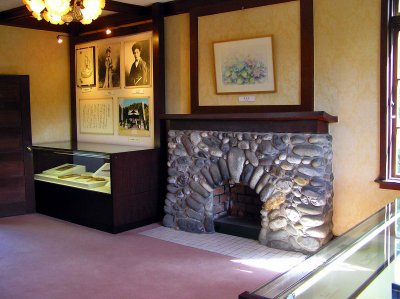 |
Field of mitsuba-tsutsuji azalea |
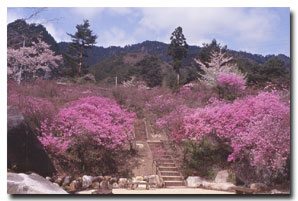
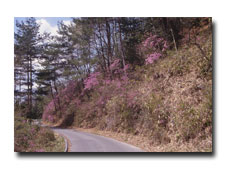
An azalea garden filled by mitsuba-tsutsuji azalea (a natural monument). The blooming season is in mid-April. There are about 400 azalea shrubs in the garden. Among them, Nagiso mitsuba-tsutsuji azalea, as the name implies, is a rare kind only seen around this town. The garden is located on a hill in the park and visitors can enjoy an outstanding views of the Momosuke Bridge and Mt. Kisokomagatake.
The Esugata Sotai Dosojin (travelers' roadside guardian deities) is also nearby.
Azalea blossoms updates are available in the 'Travel News' section as the blooming season approaches.
Please refer to the “Seasonal Attractions” page where we introduce the flowers that can be seen in Nagiso town, including mitsuba-tsutsuji.
Kakizore Aqueduct |
This concrete aqueduct was built across Kakizore River, and is a leading waterway to the Yomikaki Power Station. The total length is 142.4 m. The Central section is a double arch bridge, and both ends are girder bridges. It is one of the largest existing aqueduct bridges built before the war. |
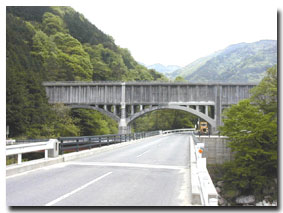 |
 |
Yomikaki Power Station |
This power station was built between November 1921 and December 1922 by Daido Electric Power Company, as a waterway style power plant with a maximum output of 40,700 kW. During that time, the president of Daido Electric Power, Momosuke Fukuzawa, built numerous power plants along the Kiso River based on his “one river - one company” policy. The completion of the Yomikaki Power Station was a monumental event in the history of Japan’s waterway-style power plants. |
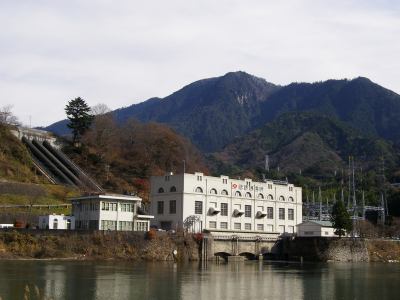 |
Constructed from reinforced concrete with brick walls and roof structure. The main building with a large, spacious room is connected to a two-story northern annex building. The building is decorated in a modern design, as seen in the structure of the semicircular windows and the skylight windows in the roof.
The concrete tank retains the original design at its front and sides. Three original steel penstocks remain, which are 2.9 m in diameter and 290-meter long.
A monument commemorating the power station's construction process. It is located near the main building and included in the designated property.
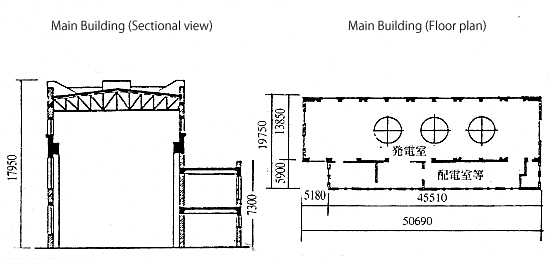 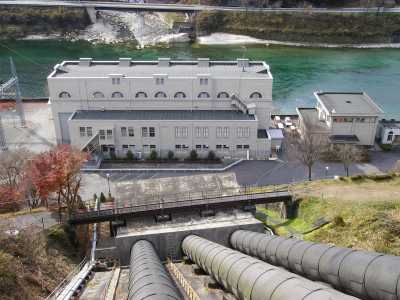 |
Momosuke Bridge |
The Momosuke Bridge, also known as the “Bridge of Peaches”, was completed in September 1922. It was built by the Daido Power Co. led by President Momosuke Fukuzawa, a man devoted to hydroelectric development. The bridge was for the transportation of construction materials for the Yomikaki Power Plant (completed in 1923). |
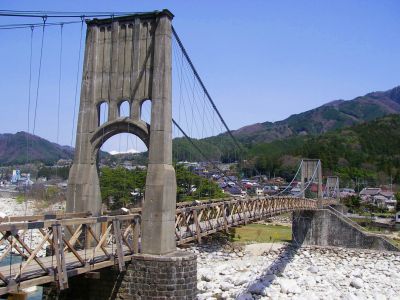 |
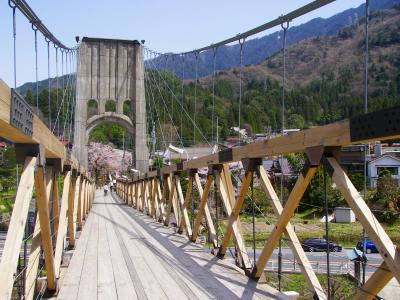 | |
The Momosuke Bridge is 247 m in length and 2.7 m wide. It crosses over the widest part of the river and contributes to the beautiful and majestic scenery. |
| Bridge length | 247.762 m |
|---|---|
| Width | 2.728 m |
| Span | The two sections of the central span cover 104.442 m, and 104.496 m Left bank side spans 23.950 m. Right bank side spans 14.874 m |
| Auxiliary steel truss height | 2.333 m |
| Main tower height | Reinforced steel concrete, 13.300 m Mixed stone footing (Central) 14.326 m |
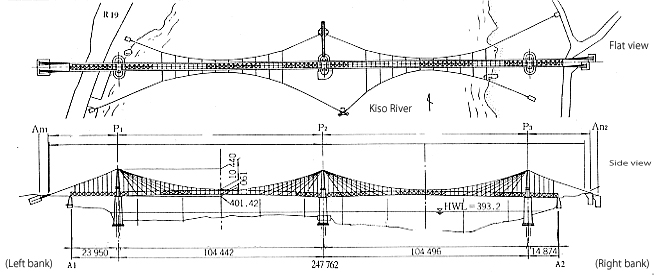
| Link Guidelines | Privacy Policy | Sitemap |
| Nagiso Town Tourism Association |
Copyright1997 Nagiso Town. |